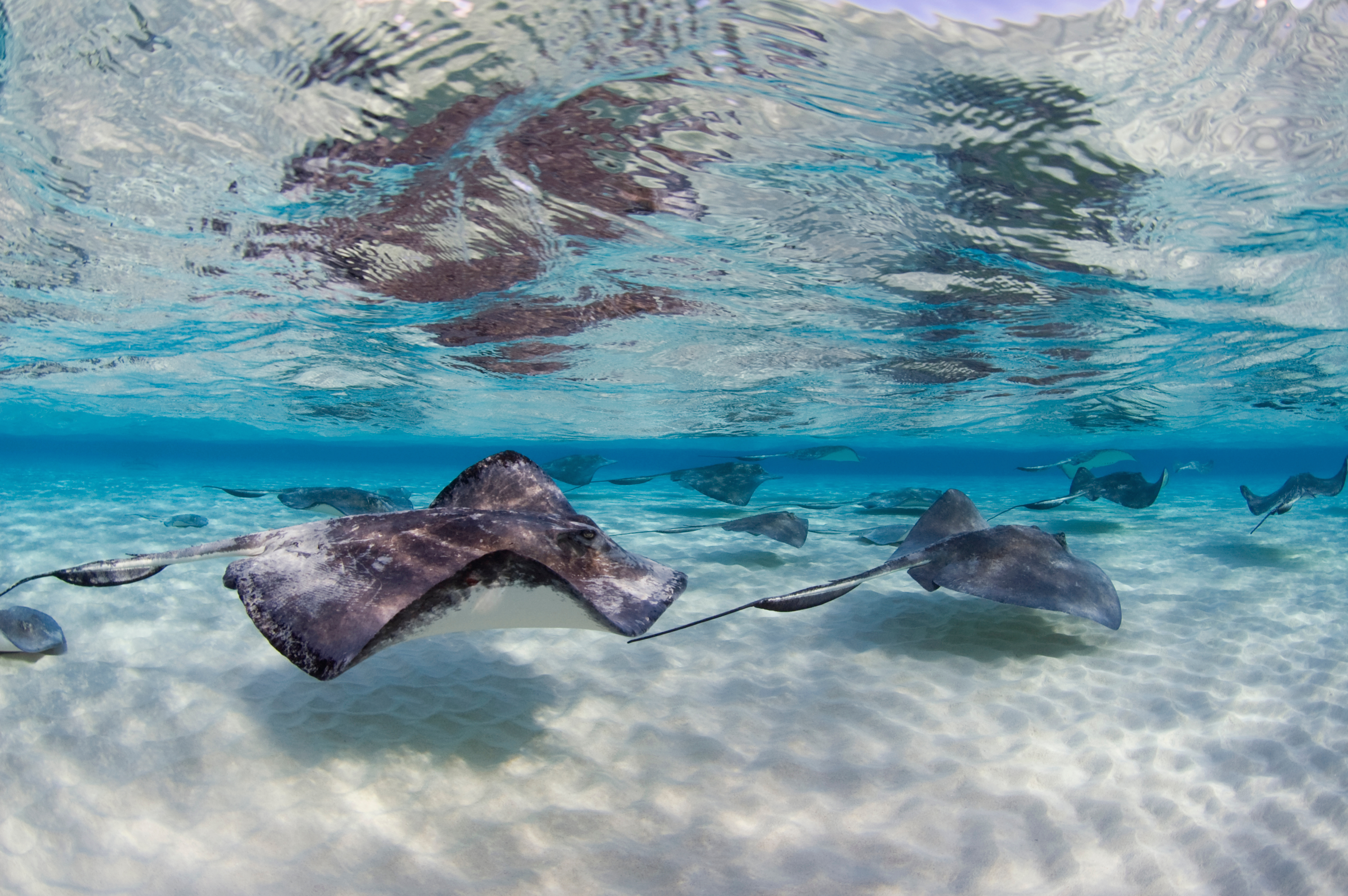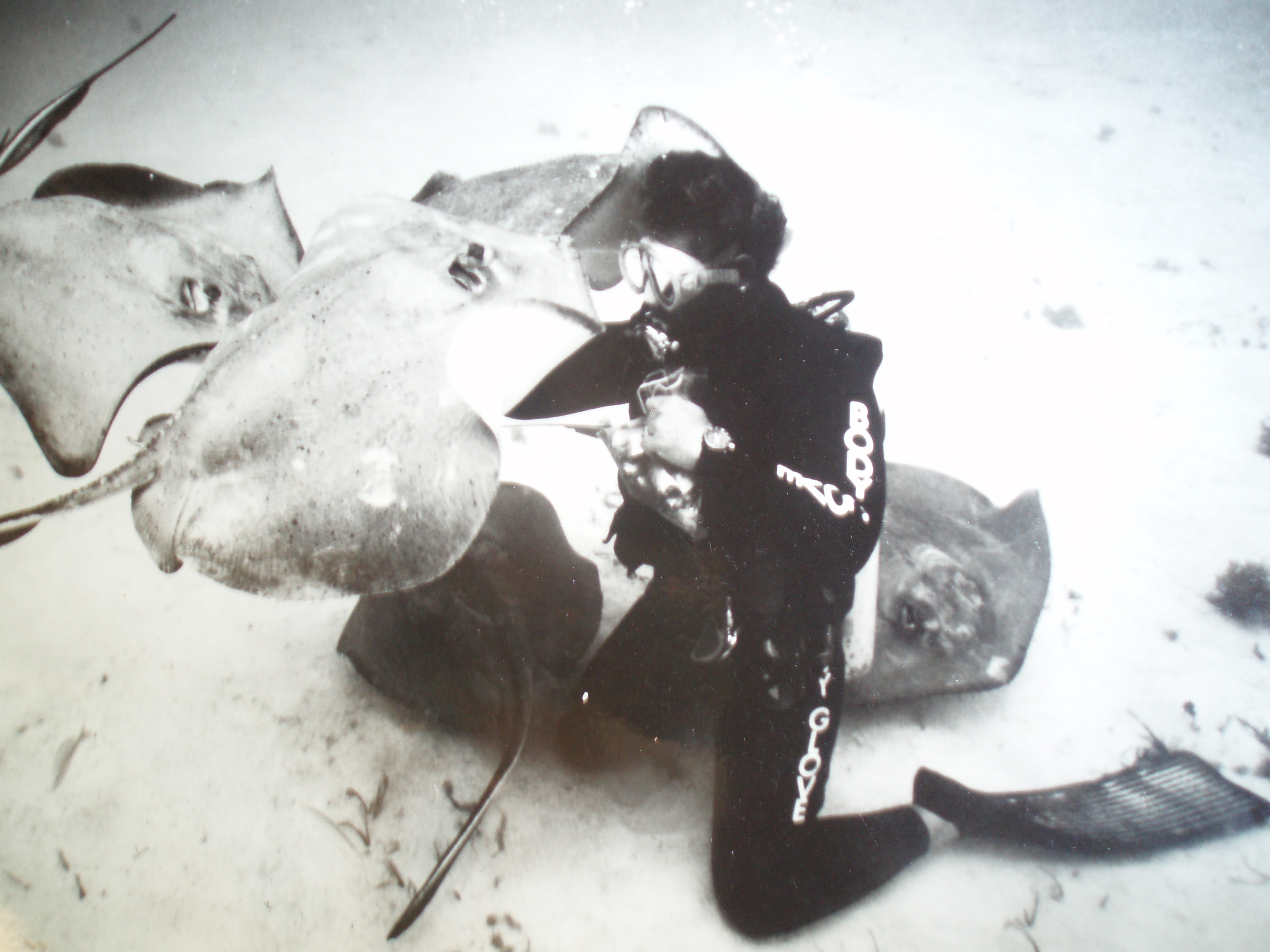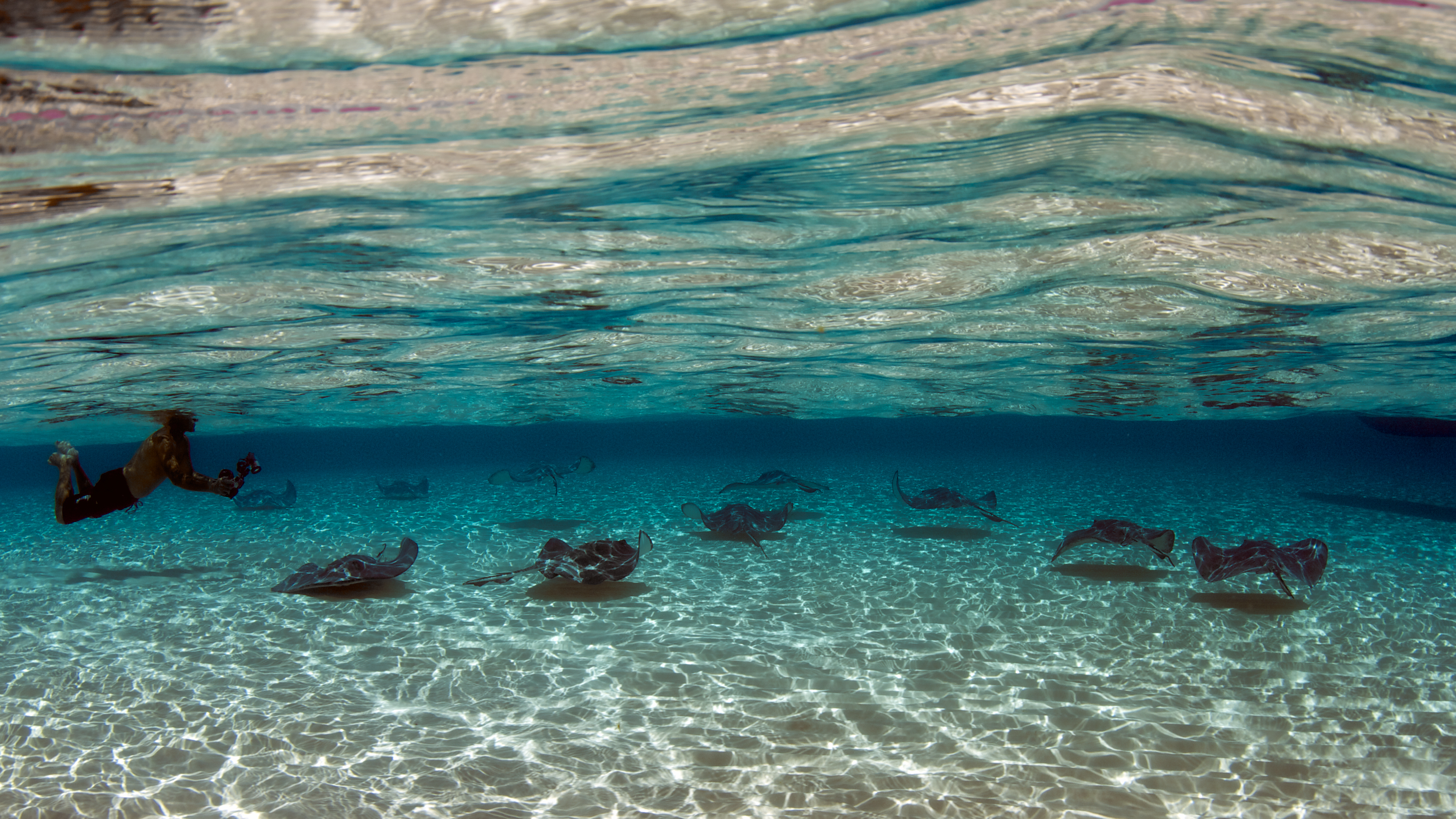Marine Life & Conservation
Stingray City, Cayman’s No.1 Tourism Attraction, Enjoys Full Protection

For more than 30 years, those who have dived and snorkelled in Grand Cayman have enjoyed a unique first-hand encounter with dozens of friendly stingrays that gather at two sites in the clear waters of the North Sound − Stingray City and the sandbar. This creature experience is on the bucket lists of divers across the world. The celebrity rays have been featured on the front page of the Wall Street Journal, the cover of National Geographic Magazine, and most dive publications. NBC’s Al Roker dived with the rays in 1989 and put them on network TV. The exposure has made Stingray City one of the most popular dive and snorkel sites in the world, and it contributes significantly to the local tourism economy.
Cayman’s celebrity stingrays are now under the full legal protection of the Cayman Islands Government, which amended its New Conservation Law to extend protection to Southern Stingrays in Cayman Waters. Before the amendment, the law only protected them in the Sandbar or Stingray City, designated as Wildlife Interaction Zones, and in marine parks or designated environmental zones. The amendment to the Conservation Law also extends protection to Eagle Rays and Manta Rays in local waters.
Members of the Cayman Islands Tourism Association have always supported efforts to protect the Southern Stingray and the move by the government is welcomed. Everyone understands how vital Stingray City is to Cayman’s tourism product.
Steve Broadbelt, co-founder of Ocean Frontiers: “Many have tried to copy Stingray City, others have even tried to poach and export our Southern Stingrays, but nothing comes close to the wild aggregations of Stingrays we have in the Cayman Islands. Stingrays are critical to tourism in Cayman as it gives us a competitive edge over other destinations in the region – everybody loves Stingrays.”
The beginnings of Stingray City can be traced to the island’s early days when local fishermen cleaned their catch in the shallows of the North Sound, attracting the stingrays, which are bottom feeders. Then divemasters doing surface intervals between dives on the North Wall noticed the circling rays and began feeding them.
“I can remember they would come to me and snuggle like puppy dogs, they were wonderful!” recalls Kenney, one of those divemasters and a long-time Red Sail Sports staffer. The divemasters helped dispel the bad myths surrounding stingrays and the Stingray City experience took off. This experience with the friendly rays has thrilled thousands and made Stingray City the number one dive and snorkel site in the Cayman Islands.
“It’s a natural aquarium, not man-made. No Stingrays are caught and kept in captivity so it’s authentic and the rays come and go as they please,” says Nancy Easterbrook, owner of Divetech. “In addition to playing with the gentle Southern Stingrays, green moray eels will visit you, school of blue tangs and snappers and small coral heads reveal their inhabitants if you stop and look closely. In 12 feet of crystal clear water, it’s the ideal photographers dream – no wonder millions have visited the site over the years and has a special place in their dive logs.”
The Cayman Islands Department of Environment introduced guidelines in 2007 to manage traffic at the stingray sites and actual handling of the rays. Dive operators emphasize these rules to visitors before they enter the water.
“Our briefings cover the highlights of the marine conservation laws as applicable to the Wildlife Interaction Zones, including why the regulations make sense, so people understand how to safely enjoy the ‘aquarium’ for both their protection and the Stingrays protection,” says Steve Broadbelt. “In general we tell guests to watch and observe the rays, and not molest or annoy them.”
Red Sail Sports dive boats also include an introduction to “Fluffy” the stuffed stingray during dive briefings. “The stuffed stingray is used to demonstrate the anatomy of the stingrays – where the mouth is, the gills, how they breathe, how they feed, and of course the tail including the barb,” says Dive Operations Manager Clive Webb. “This lets the guests know where they can touch the Stingrays, what they feel like both on top and underneath, and what to pay attention to and be careful of. We also include the contribution by our own Pat Kenney being one of the first to get in with the rays.”
An annual census by conservationist Guy Harvey, with assistance and oversight by the Department of Environment, helps monitor the health of the rays and the dynamics at both sites. According to the latest count 90 stingrays frequent both Stingray City and the Sandbar. Most are female and many of them are pregnant. This year 48 new stingrays have been tagged in the census.
Jessica Harvey, Research Officer, Cayman Islands Department of Environment: “With each ray having a PIT tag, a microchip under the skin, we can determine exactly who we see on a given day, and just as importantly, who we haven’t seen. One female in particular we hadn’t seen since before 2012!”
 “Even with the best wall dives, vibrant coral reefs and massive shipwrecks in the Cayman Islands, when a diver sees an image of a Stingray playing with a diver or snorkeler, that photo needs no caption of where it was taken,” says Steve Broadbelt. “Even today, whether it’s your first time or 100th time, the rays never lose their magic and shine a memory that only those who know can fully understand.”
“Even with the best wall dives, vibrant coral reefs and massive shipwrecks in the Cayman Islands, when a diver sees an image of a Stingray playing with a diver or snorkeler, that photo needs no caption of where it was taken,” says Steve Broadbelt. “Even today, whether it’s your first time or 100th time, the rays never lose their magic and shine a memory that only those who know can fully understand.”
Marine Life & Conservation
Paul Watson Released as Denmark Blocks Japan’s Extradition Bid

Renowned anti-whaling activist Paul Watson has been released from custody in Greenland after spending five months in detention. Denmark’s Justice Ministry rejected Japan’s request for his extradition, citing insufficient guarantees that his time already served in custody would be credited against any potential sentence.
The 74-year-old Canadian-American was arrested on July 21 in Nuuk, Greenland’s capital, when his ship docked to refuel. His arrest was based on a 2012 Japanese warrant related to a 2010 encounter in Antarctic waters. Japan alleged Watson obstructed operations and caused damage to a whaling research ship during efforts to disrupt illegal whaling. Watson has consistently denied these claims, maintaining his commitment to marine conservation.
Denmark, which oversees extradition matters for Greenland, concluded that while the legal conditions for extradition were met, the lack of assurances from Japan regarding time-served credit made extradition untenable.
In a video shared by his foundation, Watson expressed gratitude and relief, saying, “After five months, it’s good to be out… and good to know they’re not sending me to Japan.” He added that the most difficult part of his time in custody was being separated from his two young sons.
Watson is a pioneering figure in marine conservation, known for founding the Captain Paul Watson Foundation in 2022 after decades of activism with the Sea Shepherd Conservation Society. His bold efforts to defend marine life have earned him widespread support, including from celebrities and conservationists. His work has also been featured in the acclaimed reality TV series Whale Wars.
Watson’s lawyer, Jonas Christoffersen, praised the decision, stating, “We are happy and relieved that Paul Watson is now free.” He added that Watson is eager to reunite with his family and continue his vital work.
The arrest occurred while Watson’s vessel, the M/Y John Paul DeJoria, was en route to the North Pacific with a team of 26 volunteers to intercept a Japanese whaling ship. His foundation described the arrest as politically motivated and emphasized that Watson’s actions were focused on ending illegal whaling practices.
Japan resumed commercial whaling in 2019 after leaving the International Whaling Commission, asserting that whale meat is a cultural tradition. Conservationists, however, continue to challenge these practices, highlighting their impact on marine ecosystems.
Despite the challenges, Watson remains steadfast in his mission to protect marine life and bring attention to whaling practices. His dedication to ocean conservation has made him a globally respected advocate for the environment.
Marine Life & Conservation
12 Days of Zero-Waste Fish-mas

This holiday period, the Marine Conservation Society, the UK’s leading ocean membership charity, invites you to make some simple changes to eating fish this Christmas to help our seas.
Dr Kenneth Bodles, Head of Fisheries and Aquaculture at the Marine Conservation Society, said, “During the festive season, our consumption increases, but so does waste. Sustainability isn’t just about where food comes from – it’s also about how you use it. By reducing waste and making the most out of your seafood, you’re not only taking steps to be more ocean-friendly, but can also help to cut costs during what is often one of the most expensive times of the year”.
The Marine Conservation Society has compiled twelve tips on how to consume seafood sustainably with zero-waste this Christmas:
Buy whole fish instead of fillets
Instead of fillets, consider buying whole fish such as salmon, hake, or lemon sole. By adopting a “nose to tail” approach with cooking, whole-baked fish not only feeds a crowd, but also helps to minimise waste and maximise sustainability by using up every part of the animal, including bones, skin, and fat.
Make fish stock
Leftover fish bones or shells can be put to good use by boiling them to make a nourishing fish stock or bisque. This can be frozen and preserved for later use and makes for a flavourful base in a soup.
Make your own fish pâté
Avoid waste by turning leftover fish, such as smoked mackerel or salmon, into a delicious pâté by blending with cream cheese and lemon. Perfect when paired with crackers.
The sustainability of salmon and mackerel varies depending on where and how it is caught or farmed. For more information on green-rated options, check the charity’s Good Fish Guide.
Buy frozen
By purchasing seafood that is frozen or vacuum-packed, this helps to reduce waste by extending the shelf life of your food.
Fish pie
If you’re wondering what to do with leftover cooked fish, why not opt for a classic fish pie with mashed potatoes, leeks, and a cheesy sauce? A sure crowd pleaser on Boxing Day.
Use the head
Don’t forget the fish head! The meat is incredibly tender and flavourful. The charity recommends a cod’s head curry or recreating Fallow’s renowned cod’s head in siracha butter.
By stretching your ingredients further, not only is this a more sustainable way to enjoy seafood, but also cost-effective by repurposing leftovers and cooking creatively.
Boxing Day brunch
Mix leftover kippers or smoked salmon with scrambled eggs for a tasty, zero-waste, Boxing Day brunch.
For best choice, make sure you buy kippers, or herring, from the North Sea and the North Irish Sea.
Zero-waste storage
A top tip from the Marine Conservation Society to avoid waste is freezing fish offcuts to save for future use.
Crisp up the skin
Even leftover fish skin can be turned into a quick savoury snack by crisping it up in an air fryer with a little olive oil and salt.
Anchovies two ways
Leftover anchovies can either be blended with butter to make a delicious anchovy butter or tossed into pasta for a hit of umami flavour.
The charity recommends opting for anchovies caught in the Bay of Biscay for best choice.
Fishcakes
For an easy, zero-waste meal, leftover seafood trimmings can be mixed with mash and fried in breadcrumbs to make fishcakes.
Pickled mussels
Try pickling mussels in 1:1 vinegar and water, with a dash of sugar for a sustainable, zero-waste snack that can be enjoyed well beyond the festive season.
Mussels farmed in the UK are a seafood superhero. Grown using low-impact methods and harvested by hand, they get all the food they need from the sea around them. This makes them one of the most sustainable, ocean-friendly, and cost-effective seafood options.
Players of People’s Postcode Lottery have raised £6.6M towards the Marine Conservation Society’s vital work in making seafood more sustainable.
Laura Chow, Head of Charities at People’s Postcode Lottery, said: “Fish is a festive favourite for many, but making sustainable choices when it comes to how we buy and eat seafood makes all the difference for our ocean. Support from players of People’s Postcode Lottery has helped the Marine Conservation Society further its sustainable seafood work, so that we can all enjoy healthier, better protected seas.”
The Marine Conservation Society encourages you to make sustainable seafood choices a year-round habit, not just for Christmas. To check how sustainable the seafood on your plate is, you can visit the charity’s Good Fish Guide. The Guide helps consumers and businesses identify the most sustainable seafood using a simple traffic light system, based on where and how species are caught or farmed. Green is the best choice, amber means improvements are needed, and red indicates fish to avoid buying.
Zero-waste gift idea
Why not embrace a zero-waste Christmas by gifting a membership to support marine conservation? It’s a meaningful, low-waste gift that helps protect our ocean for generations to come. Memberships start from as little as £5 a month – the price of a sandwich and drink from your local coffee shop.
Find the latest sustainable seafood advice for wild-caught and farmed seafood on the Good Fish Guide, downloadable to your phone from www.mcsuk.org/goodfishguide.
-

 News2 months ago
News2 months agoIconic SS United States to become the World’s Largest Artificial Reef
-

 News3 months ago
News3 months agoBook Review – 52 Assignments: Underwater Photography
-

 Gear News3 months ago
Gear News3 months agoDYNAMICNORD – New German diving brand enters the British market
-

 News3 months ago
News3 months agoExploring Cenote El Pit: A Diver’s Dream
-

 Gear News3 months ago
Gear News3 months agoTry BARE drysuits (and maybe even win one!) this Friday with Sea & Sea at North West Dive Fest
-

 Marine Life & Conservation3 months ago
Marine Life & Conservation3 months agoBook Review: Coral Triangle Cameos
-

 Blogs2 months ago
Blogs2 months agoDive the Egyptian Red Sea this Autumn with Regaldive
-

 News3 months ago
News3 months ago2024 Ocean Art Underwater Photo Competition Announced





















